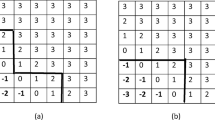Abstract
Comparing and ranking information is an important topic in social and information sciences, and in particular on the web. Its objective is to measure the difference of the preferences of voters on a set of candidates and to compute a consensus ranking. Commonly, each voter provides a total order of all candidates. Recently, this approach has been generalized to bucket orders, which allow ties.
In this work we further generalize and consider total, bucket, interval and partial orders. The disagreement between two orders is measured by the nearest neighbor Spearman footrule distance, which has not been studied so far. We show that the nearest neighbor Spearman footrule distance of two bucket orders and of a total and an interval order can be computed in linear time, whereas the computation is NP-complete and 6-approximable for a total and a partial order. Moreover, we establish the NP-completeness and the 4-approximability of the rank aggregation problem for bucket orders. This sharply contrasts the well-known efficient solution of this problem for total orders.
Access this chapter
Tax calculation will be finalised at checkout
Purchases are for personal use only
Preview
Unable to display preview. Download preview PDF.
Similar content being viewed by others
References
Ailon, N.: Aggregation of partial rankings, p-ratings and top-k lists. Algorithmica 57, 284–300 (2010)
Aslam, J.A., Montague, M.H.: Models for metasearch. In: Proceedings of the 24th Annual International Conference on Research and Development in Information Retrieval (SIGIR), pp. 275–284. ACM, New York (2001)
Bartholdi III, J.J., Tovey, C.A., Trick, M.A.: Voting schemes for which it can be difficult to tell who won the election. Social Choice and Welfare 6, 157–165 (1989)
Betzler, N., Dorn, B.: Towards a dichotomy for the possible winner problem in elections based on scoring rules. Journal of Computer and System Sciences 76, 812–836 (2010)
Biedl, T., Brandenburg, F.J., Deng, X.: On the complexity of crossings in permutations. Discrete Mathematics 309, 1813–1823 (2009)
Borda, J.C.: Mémoire aux les élections au scrutin (1781)
Cohen, W.W., Schapire, R.E., Singer, Y.: Learning to order things. Journal of Artificial Intelligence Research 10, 243–270 (1999)
Condorcet, M.-J.: Éssai sur l’application de l’analyse à la probalité des décisions rendues à la pluralité des voix (1785)
Critchlow, D.E.: Metric methods for analyzing partially ranked data. Lecture Notes in Statistics, vol. 34. Springer, Berlin (1985)
Diaconis, P., Graham, R.L.: Spearman’s footrule as a measure of disarray. Journal of the Royal Statistical Society, Series B 39, 262–268 (1977)
Dwork, C., Kumar, R., Naor, M., Sivakumar, D.: Rank aggregation methods for the web. In: Proceedings of the 10th International World Wide Web Conference (WWW 2010), pp. 613–622 (2001)
Fagin, R., Kumar, R., Mahdian, M., Sivakumar, D., Vee, E.: Comparing partial rankings. SIAM Journal on Discrete Mathematics 20, 628–648 (2006)
Garey, M.R., Johnson, D.S.: Computers and Intractability; A Guide to the Theory of NP-Completeness. W. H. Freeman & Co., New York (1990)
Hemaspaandra, E., Hemaspaandra, L.A., Rothe, J.: Exact analysis of Dodgson elections: Lewis Carroll’s 1876 voting system is complete for parallel access to NP. Journal of the ACM 44, 806–825 (1997)
Lebanon, G., Lafferty, J.D.: Cranking: Combining rankings using conditional probability models on permutations. In: Proceedings of the 19th International Conference Machine Learning (ICML), pp. 363–370. Morgan Kaufmann, San Francisco (2002)
Lullus, R.: Artifitium electionis personarum (1283)
Lullus, R.: De arte eleccionis (1299)
Montague, M.H., Aslam, J.A.: Condorcet fusion for improved retrieval. In: Proceedings of the 2002 International Conference on Information and Knowledge Management (CIKM), pp. 538–548. ACM, New York (2002)
Renda, M.E., Straccia, U.: Web metasearch: Rank vs. score based rank aggregation methods. In: Proceedings of the 2003 Symposium on Applied Computing (SAC), pp. 841–846. ACM, New York (2003)
Sese, J., Morishita, S.: Rank aggregation method for biological databases. Genome Informatics 12, 506–507 (2001)
van Zuylen, A., Hegde, R., Jain, K., Williamson, D.P.: Deterministic pivoting algorithms for constrained ranking and clustering problems. In: Proceedings of the 18th Annual ACM-SIAM Symposium on Discrete Algorithms (SODA), pp. 405–414 (2007)
van Zuylen, A., Williamson, D.P.: Deterministic pivoting algorithms for constrained ranking and clustering problems. Mathematics of Operations Research 34, 594–620 (2009)
Xia, L., Conitzer, V.: Determining possible and necessary winners under common voting rules given partial orders. In: Proceedings of the 23rd National Conference on Artificial Intelligence (AAAI), pp. 196–201. AAAI Press, Menlo Park (2008)
Yager, R.R., Kreinovich, V.: On how to merge sorted lists coming from different web search tools. Soft Computing Research Journal 3, 83–88 (1999)
Author information
Authors and Affiliations
Editor information
Editors and Affiliations
Rights and permissions
Copyright information
© 2011 Springer-Verlag Berlin Heidelberg
About this paper
Cite this paper
Brandenburg, F.J., Gleißner, A., Hofmeier, A. (2011). The Nearest Neighbor Spearman Footrule Distance for Bucket, Interval, and Partial Orders. In: Atallah, M., Li, XY., Zhu, B. (eds) Frontiers in Algorithmics and Algorithmic Aspects in Information and Management. Lecture Notes in Computer Science, vol 6681. Springer, Berlin, Heidelberg. https://doi.org/10.1007/978-3-642-21204-8_37
Download citation
DOI: https://doi.org/10.1007/978-3-642-21204-8_37
Publisher Name: Springer, Berlin, Heidelberg
Print ISBN: 978-3-642-21203-1
Online ISBN: 978-3-642-21204-8
eBook Packages: Computer ScienceComputer Science (R0)




